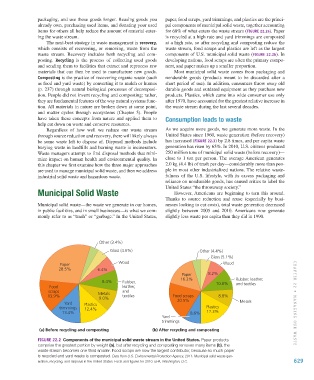Page 630 - Environment: The Science Behind the Stories
P. 630
packaging, and use those goods longer. Reusing goods you paper, food scraps, yard trimmings, and plastics are the princi-
already own, purchasing used items, and donating your used pal components of municipal solid waste, together accounting
items for others all help reduce the amount of material enter- for 68% of what enters the waste stream (FIGURE 22.2a). Paper
ing the waste stream. is recycled at a high rate and yard trimmings are composted
The next-best strategy in waste management is recovery, at a high rate, so after recycling and composting reduce the
which consists of recovering, or removing, waste from the waste stream, food scraps and plastics are left as the largest
waste stream. Recovery includes both recycling and com- components of U.S. municipal solid waste (FIGURE 22.2b). In
posting. Recycling is the process of collecting used goods developing nations, food scraps are often the primary compo-
and sending them to facilities that extract and reprocess raw nent, and paper makes up a smaller proportion.
materials that can then be used to manufacture new goods. Most municipal solid waste comes from packaging and
Composting is the practice of recovering organic waste (such nondurable goods (products meant to be discarded after a
as food and yard waste) by converting it to mulch or humus short period of use). In addition, consumers throw away old
(p. 237) through natural biological processes of decomposi- durable goods and outdated equipment as they purchase new
tion. People did not invent recycling and composting; rather, products. Plastics, which came into wide consumer use only
they are fundamental features of the way natural systems func- after 1970, have accounted for the greatest relative increase in
tion. All materials in nature are broken down at some point, the waste stream during the last several decades.
and matter cycles through ecosystems (Chapter 5). People
have taken these concepts from nature and applied them to Consumption leads to waste
help cut down on waste and conserve resources.
Regardless of how well we reduce our waste stream As we acquire more goods, we generate more waste. In the
through source reduction and recovery, there will likely always United States since 1960, waste generation (before recovery)
be some waste left to dispose of. Disposal methods include has increased (FIGURE 22.3) by 2.8 times, and per capita waste
burying waste in landfills and burning waste in incinerators. generation has risen by 65%. In 2010, U.S. citizens produced
Waste managers attempt to find disposal methods that mini- 250 million tons of municipal solid waste (before recovery)—
mize impact on human health and environmental quality. In close to 1 ton per person. The average American generates
this chapter we first examine how the three major approaches 2.0 kg (4.4 lb) of trash per day—considerably more than peo-
are used to manage municipal solid waste, and then we address ple in most other industrialized nations. The relative waste-
industrial solid waste and hazardous waste. fulness of the U.S. lifestyle, with its excess packaging and
reliance on nondurable goods, has caused critics to label the
United States “the throwaway society.”
Municipal Solid Waste However, Americans are beginning to turn this around.
Thanks to source reduction and reuse (especially by busi-
Municipal solid waste—the waste we generate in our homes, nesses looking to cut costs), total waste generation decreased
in public facilities, and in small businesses—is what we com- slightly between 2005 and 2010. Americans now generate
monly refer to as “trash” or “garbage.” In the United States, slightly less waste per capita than they did in 1990.
Other (3.4%)
Glass (4.6%) Other (4.4%)
Glass (5.1%)
Wood Wood
Paper
28.5% 6.4%
Paper 8.2%
16.2% Rubber, leather,
8.4% Rubber, 10.8% and textiles
Food leather,
scraps and
13.9% Metals textiles Food scraps 8.8%
9.0%
Yard Plastics 20.5% Metals CHAPTER 22 • MAN A GING OUR WASTE
trimmings 12.4% Plastics
13.4% 8.6% 17.3%
Yard
trimmings
(a) Before recycling and composting (b) After recycling and composting
FIGURE 22.2 Components of the municipal solid waste stream in the United States. Paper products
comprise the greatest portion by weight (a), but after recycling and composting removes many items (b), the
waste stream becomes one-third smaller. Food scraps are now the largest contributor, because so much paper
is recycled and yard waste is composted. Data from U.S. Environmental Protection Agency, 2011. Municipal solid waste gen-
eration, recycling, and disposal in the United States: Facts and figures for 2010. EPA, Washington, D.C. 629
M22_WITH7428_05_SE_C22.indd 629 13/12/14 2:25 PM

